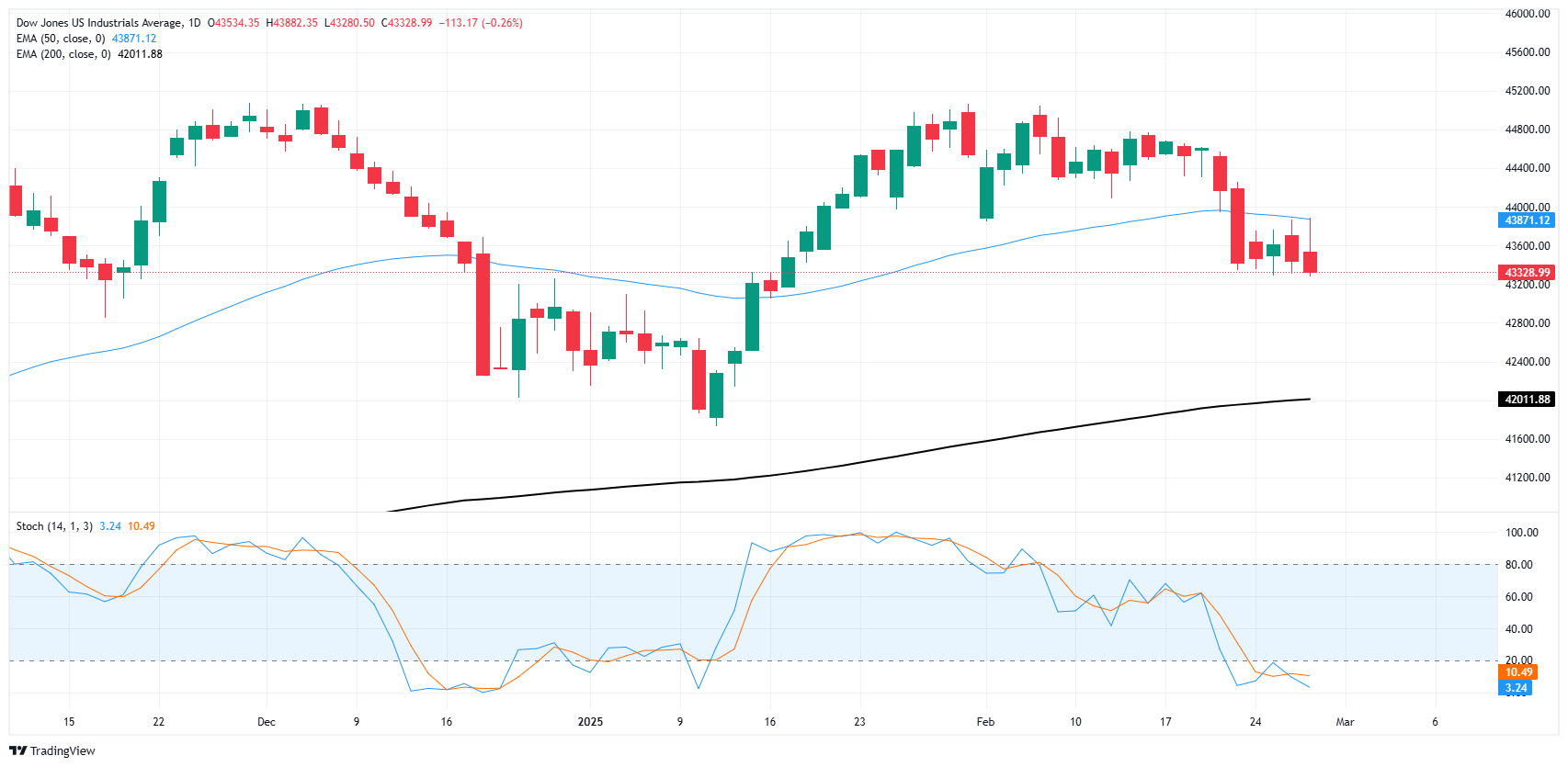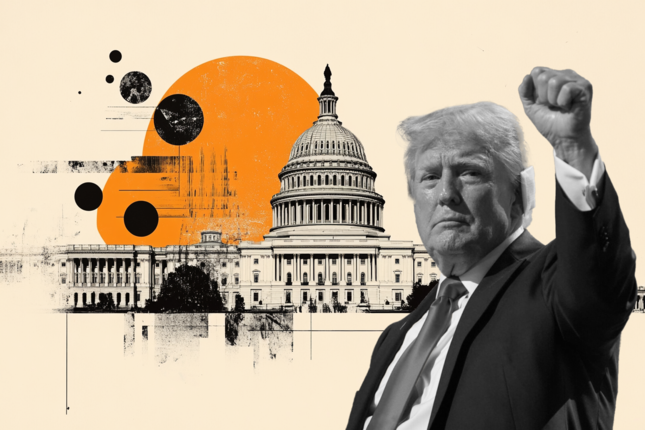Dow Jones Industrial Average fails to shrug off new tariff threats
- The Dow Jones rose around 400 points at its peak on Thursday.
- Despite further tariff changes from President Trump, equities are looking up.
- Investors have become inoculated to tariff threats, but volatility pressures remain.
The Dow Jones Industrial Average (DJIA) knocked around 400 points higher at its highest on Thursday, driven by a heavy bounceback in overweight stocks listed on the Dow Jones. Geopolitical factors proved too much for equities, and the Dow Jones receded on the day, falling to a 120 points decline. United States (US) President Donald Trump refreshed his threats of imposing a 25% tariff package on Canada and Mexico, but investors have gotten a lot of practice assuming the Trump administration will find a last-minute reason to pivot away from its own arbitrary schedules.
President Trump reversed his own timeline for new tariffs in the early hours of Thursday’s US market session, pivoting from an April 2 start date for 25% tariffs on Canada and Mexico, as well as an additional 10% import fee on Chinese goods, to now begin on March 4. “Reciprocal tariffs” that will be imposed on a much wider swath of US trading partners are still slated for implementation on April 2, though specific details still remain elusive on both sets of tariffs.
Despite continued wavering from the Trump administration and cyclical headline churn on tariffs, investors continue to bet that a last-minute deal or delay will be found on the latest round of import taxes being threatened by President Trump.
US President Donald Trump reiterates March 4 tariffs, still seeking Ukraine deal
On the economic data front, US Gross Domestic Product (GDP) growth for the fourth quarter beat forecasts on the front end of the curve, while Durable Goods spending accelerated faster than expected in January. US Q4 GDP rose to 2.4% QoQ compared to the expected hold at 2.2%, but the annualized figure held steady at 2.3%.
US Durable Goods Orders accelerated to 3.1% MoM in January, beating the expected print of 2.0% and swinging well above the revised previous figure of -1.8%. A welcome print for economy watchers, it doesn’t come without its drawbacks: much of the figure is likely businesses stuffing their inventories ahead of potential tariffs, and a recent uptick in inflation may be boosting the numbers artificially, which could pose a larger problem down the line.
It’s worth noting that much of the uptick in Durable Goods Orders can be found in the transportation sector following a large swell in bookings for Boeing (BA) airplanes and automotive vehicles. Without these factors, US Durable Goods Orders actually came in at a flat 0.0% in January, missing the forecast of 0.3% and coming in below the revised previous print of 0.1%.
US Personal Consumption Expenditure Price Index (PCEPI) inflation is due on Friday, but Thursday’s preview release bodes poorly for investors pinning their hopes that a recent uptick in headline inflation figures will be temporary. QoQ Core PCE, a preview of Friday’s main inflation print, accelerated to 2,7% from the expected hold at 2.5%.
Dow Jones news
Over two-thirds of the Dow Jones equity board is drifting into the high side on Thursday, but outsized losses in key overweight securities are dragging the average lower on the day. 3M (MMM) is up 3% on Thursday, climbing above $151 per share. UnitedHealth (UNH) added 1.65%, climbing above $471 per share and adding 8 points. UNH is the second-highest-weighted stock listed on the Dow Jones, and a few points added or removed from the share price has a pronounced impact on the Dow’s headline.
Nvidia (NVDA) tumbled 6.3%, falling below $123 per share and dragging the Dow Jones lower overall. Because Nvidia's share price is overall on the low end compared to the rest of the Dow, headline moves in the index were minimized, but a fresh plunge from Nvidia was enough to force the DJIA into the low end on Thursday.
Dow Jones price forecast
A near-term consolidation pattern continues to cook into the Dow Jones chart, with price action hobbled just south of the 50-day Exponential Moving Average (EMA) near 43,885. Technical traders will be looking for an opportunity to step back into a bullish rebound with technical oscillators rolling over in oversold territory, but it won’t take much for a downside plunge to drag bids closer to the 200-day EMA parked near the 42,000 major price handle.
Dow Jones daily chart
Dow Jones FAQs
The Dow Jones Industrial Average, one of the oldest stock market indices in the world, is compiled of the 30 most traded stocks in the US. The index is price-weighted rather than weighted by capitalization. It is calculated by summing the prices of the constituent stocks and dividing them by a factor, currently 0.152. The index was founded by Charles Dow, who also founded the Wall Street Journal. In later years it has been criticized for not being broadly representative enough because it only tracks 30 conglomerates, unlike broader indices such as the S&P 500.
Many different factors drive the Dow Jones Industrial Average (DJIA). The aggregate performance of the component companies revealed in quarterly company earnings reports is the main one. US and global macroeconomic data also contributes as it impacts on investor sentiment. The level of interest rates, set by the Federal Reserve (Fed), also influences the DJIA as it affects the cost of credit, on which many corporations are heavily reliant. Therefore, inflation can be a major driver as well as other metrics which impact the Fed decisions.
Dow Theory is a method for identifying the primary trend of the stock market developed by Charles Dow. A key step is to compare the direction of the Dow Jones Industrial Average (DJIA) and the Dow Jones Transportation Average (DJTA) and only follow trends where both are moving in the same direction. Volume is a confirmatory criteria. The theory uses elements of peak and trough analysis. Dow’s theory posits three trend phases: accumulation, when smart money starts buying or selling; public participation, when the wider public joins in; and distribution, when the smart money exits.
There are a number of ways to trade the DJIA. One is to use ETFs which allow investors to trade the DJIA as a single security, rather than having to buy shares in all 30 constituent companies. A leading example is the SPDR Dow Jones Industrial Average ETF (DIA). DJIA futures contracts enable traders to speculate on the future value of the index and Options provide the right, but not the obligation, to buy or sell the index at a predetermined price in the future. Mutual funds enable investors to buy a share of a diversified portfolio of DJIA stocks thus providing exposure to the overall index.
Forex News
Keep up with the financial markets, know what's happening and what is affecting the markets with our latest market updates. Analyze market movers, trends and build your trading strategies accordingly.























